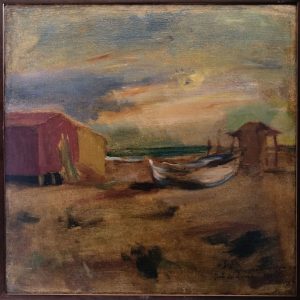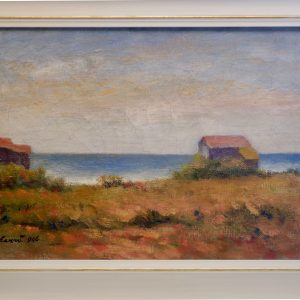Con l’opera Le Baite del 1939, Carlo Carrà concentra la sua attenzione verso il territorio montano delle Alpi Apuane, zona naturale sospesa tra il selvaggio e la presenza architettonica di costruzioni umane integrate perfettamente nel territorio. Le fasce orizzontali che dividono il dipinto in diversi piani vengono rese irregolari grazie alla presenza del piccolo complesso di baite in primo piano che segue l’andamento naturale delle frastagliate Alpi Apuane sullo sfondo, creando un parallelismo simbolico che ragiona sul senso della realtà. Con una leggera pendenza verso destra, l’occhio dello spettatore viene accompagnato ad una lettura analitica dell’opera in modo discendente; il paesaggio antropizzato, silenzioso e ritmico, è costruito tramite sovrapposizione di più elementi che, in rapporto tra di loro, fungono da piani scenografici sviluppati in profondità. Sono proprio le Alpi, dall’essenza plastica della pittura, a costruire un muro divisorio tra cielo e terra.
L’integrazione delle baite con la natura si può soprattutto notare nella prima costruzione da sinistra, dove la feritoia presente sulla facciata scorre per metà sul prato sottostante, creando una linea astratta e verticale; non è un caso che Carrà utilizzi la presenza umana come parte integrante del paesaggio montano, analizzando la realtà come integrazione completa tra uomo e natura.
Se la parte centrale è costituita da una scala di grigi che fungono da ponte tra il colore delle rocce e del cemento, la fascia alta è costituita da pennellate distese di azzurri e rosa a rendere un cielo crepuscolare, mentre la fascia bassa è costruita dalla sovrapposizione di verdi a rendere il movimento della vegetazione incolta.
Jasmin Prezioso
Storia
Esposto alla XXII Biennale di Venezia dall’aprile all’ottobre del 1940.
The lodges
Carlo Carrà
CARLO CARRA’ (1881-1966)
The lodges (1939)
Oil on canvas, 40×50 cm
Signed and dated “C.Carrà 939” down on the left
Claudia Dompè collection
With the work Le Baite (The Huts) of 1939, Carlo Carrà focused his attention on the mountainous territory of the Apuan Alps, a natural area suspended between the wild and the architectural presence of human constructions perfectly integrated into the territory. The horizontal bands dividing the painting into different planes are made irregular by the presence of the small complex of mountain lodges in the foreground, which follows the natural course of the jagged Apuan Alps in the background, creating a symbolic parallelism that reasoning about the sense of reality. With a slight slope to the right, the viewer’s eye is led to an analytical reading of the work in a descending manner; the man-made landscape, silent and rhythmic, is constructed by overlapping several elements which, in relation to each other, act as scenic planes developed in depth. It is the Alps, with the plastic essence of painting, that build a dividing wall between sky and earth.
The integration of the lodges with nature can be seen above all in the first construction from the left, where the slit in the façade runs halfway across the meadow below, creating an abstract, vertical line; it is no coincidence that Carrà uses the human presence as an integral part of the mountain landscape, analysing reality as a complete integration between man and nature.
While the central part is made up of a scale of greys that act as a bridge between the colour of the rocks and the concrete, the upper band is made up of distended brushstrokes of blues and pinks to render a twilight sky, while the lower band is built up by overlapping greens to render the movement of uncultivated vegetation.
Jasmin Prezioso
History
Esposto alla XXII Biennale di Venezia dall’aprile all’ ottobre del 1940


